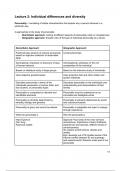Lecture 2: Individual differences and diversity
Personality = consisting of stable characteristics that explain why a person behaves in a
particular way.
2 approaches to the study of personality:
- Nomothetic approach: looking at different aspects of personality, traits or competencies
- Idiographic approach: broader view of the type of individual personality as a whole
Nomothetic Approach Idiographic Approach
Positivists bias (branch of science exclusively Constructivist bias
based on objective collection of observable
data)
Generalizing: emphasis on discovery of laws Individualizing: emphasis on the rich
of human behavior complexities of the individual
Based on statistical study of large groups Based on the intensive study of individuals
Uses objective questionnaires Uses projective test and other written and
spoken materials
Describes personality in terms of the Describes personality on the individuals own
individuals possession of various traits, and understanding and interpretations of their
trait clusters, or personality types identity
Personality is composted on discrete and Personality must be understood as an
identifiable elements indivisible and intelligible whole
Personality is primarily determined by Personality is primarily determined by social
heredity, biology and genetics and cultural processes.
Personality is given and cannot be altered Personality is adaptable and open to change
through experience.
What the personality is Why the personality is
Hans Eysenck Sigmund Freud (role of the inner self and
Carl Jung unconscious, importance of early childhood
Raymond Cattell experiences and traumas, different levels of
consciousness)
ID: present at birth (drives, desires and
needs)
Ego: develops out of ID (makes sense of the
internal conflict between ID and superego
and external world. Decision make part of our
personality
14
, Super ego: learned values and moral
standards, sense of right and wrong.
TWO DOMINANT TWO DOMINANT FRAMEWORKS USED TO DESCRIBE PERSONALITY:
1. Myers- Briggs Type Indicator (MBTI®)
2. Big Five Model
Myer-Briggs Type Indicator MBTI
Added a further dimension “style of living” to Jung's personality functions and attitudes.
Big Five Model
OCEAN acronym
- Highly conscientious people develop more job knowledge, exert greater effort, and have
better performance.
- Emotional stability is related to job satisfaction.
- Extroverts tend to be happier in their jobs and have good social skills.
- Open people are more creative and can be good leaders.
- Agreeable people are good in social settings.
15






